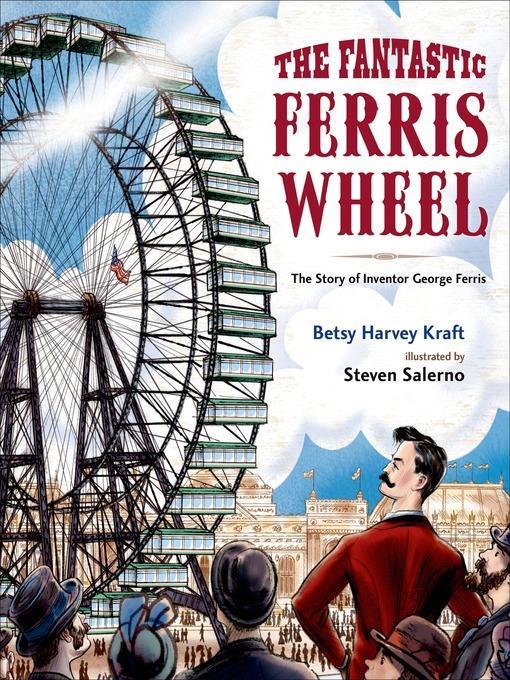
The Fantastic Ferris Wheel
The Story of Inventor George Ferris
فرمت کتاب
ebook
تاریخ انتشار
2015
Lexile Score
770
Reading Level
3-4
ATOS
4.8
Interest Level
K-3(LG)
نویسنده
Steven Salernoشابک
9781627799126
کتاب های مرتبط
- اطلاعات
- نقد و بررسی
- دیدگاه کاربران
نقد و بررسی

September 7, 2015
Kraft and Salerno highlight the technical difficulties and skepticism that accompanied the creation of what’s now known as the Ferris wheel as they profile inventor George Ferris. During preparations for the 1893 World’s Fair in Chicago, Ferris presented designs for a steam engine–driven observation wheel with 36 passenger cars. Many doubted the plausibility (and safety) of such a mechanism, but on May 1, the wheel welcomed its first passengers to soaring success. Salerno’s precisely drafted illustrations give a solid sense of the era, including intricate renderings of Chicago architecture and the construction of the wheel, while Kraft creates a genuine suspense in the lead-up to its debut. Ages 5–9.

Starred review from August 15, 2015
Heeding the call to "make big plans" for the 1893 Chicago World's Fair, George Ferris designed-and built-the giant observation wheel that now bears his name. Kraft's clear narrative sets the stage for the Columbian Exposition. Following on the 19th century's spectacular achievements in architecture and engineering, a sense of competition prevailed: the fair's organizers stood in the shadow of the Eiffel Tower, erected for France's 1889 World's Fair. Ferris' friends and Chicago's fair organizers doubted his plans for their sheer scale: how could a 26-story-tall wheel with 36 cars, each designed to carry 60 passengers, be safely constructed and operated? Ferris found investors and refined his plans. Finally, in December 1892-just 4 1/2 months before the opening-the committee gave Ferris the nod. The engineering challenges, coupled with the harsh Chicago winter, lend drama to the text; Salerno's richly detailed compositions extend it. Using traditional mixed media as well as Adobe Photoshop to layer, compose, and add color, the artist's full-bleed pictures exhibit dizzying perspective and inventive composition, adding plenty of detail, including fairgoers in period dress. A color palette of blue, green, and ochre evokes vintage postcards. Withstanding a tornado in Chicago, Ferris' wheel served again at the 1904 St. Louis World's Fair before its eventual scrapping. Kraft credits Ferris' enduring feat; a tall gatefold depicts the London Eye. An absorbing read for young makers and dreamers. (biographical note, sources) (Informational picture book. 5-9)
COPYRIGHT(2015) Kirkus Reviews, ALL RIGHTS RESERVED.

Starred review from August 1, 2015
Gr 1-3-The planners of the 1893 Chicago World's Fair were looking for a spectacular, extraordinary, and never-before-seen attraction that would draw in huge crowds. The idea they eventually accepted was George Ferris's huge observation wheel-what we now call the Ferris wheel. An amazing and awe-inspiring crowd-pleaser, the wheel was 264 feet high and held 36 passenger cars, each of which could hold 60 passengers. This book chronicles the story of Ferris's invention, explains how he overcame the initial reluctance of the members of the fair committee, and describes the glorious success of the invention, despite a storm with gale-force winds that hit Chicago during the fair. The writing is crisp, clear, and descriptive, moving the story along at a quick pace. While the narrative flows smoothly, a number of thoughts and quotes attributed to Ferris are not documented. The book's strength are the dramatic, mixed-media illustrations, which capture the enormity of Ferris's wheel and its spectacular appearance when lit up at night, that steal the show. With an old-fashioned, vintage flavor perfect for the subject matter, these spreads accurately depict the wheel and Chicago in the 1800s-its buildings and its people. Pair with Kathryn Gibbs Davis's Mr. Ferris and His Wheel (HMH, 2014) for even more information about this remarkable invention. VERDICT A strong addition to book collections dealing with inventors and inventions and useful for discussing how written texts and illustrations work together.-Myra Zarnowski, City University of New York
Copyright 2015 School Library Journal, LLC Used with permission.

September 15, 2015
Grades K-2 Nineteenth-century engineer George Ferris wanted to contribute something breathtaking to the 1893 Chicago World's Fair, and this beautifully crafted picture book shows readers how, in spite of widespread doubts, he came to design the world's first, enormous Ferris wheel. Salerno's multimedia art shows Ferris' boyhood fascination with water wheels, details of his design process, and the enthusiasm of the World's Fair attendees taking a ride. Kraft packs a lot of historical information into her narrative without overpowering the exciting story of Ferris fulfilling his thrilling dream, and the lasting influence his designs have had on the world. Excellent as a research source or an addition to STEM curriculum, this volume is likely to interest readers who delight in building and designing, and maybe even those who are timid about amusement-park rides. This kid-friendly resource is a solid choice for collections in need of thrill-ride histories or engineering and invention titles. Pair with Kathryn Gibbs Davis' Mr. Ferris and His Wheel (2014) for more freewheeling fun.(Reprinted with permission of Booklist, copyright 2015, American Library Association.)

























دیدگاه کاربران